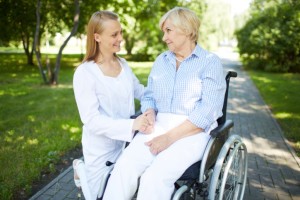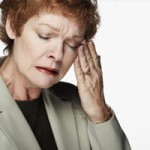Unusual signs of stroke in women
 Let’s set the record straight: Stroke isn’t just a health risk for men. According to the National Stroke Association, annually 55,000 more women are dying of stroke than men, making it the third leading cause of death for women.
Let’s set the record straight: Stroke isn’t just a health risk for men. According to the National Stroke Association, annually 55,000 more women are dying of stroke than men, making it the third leading cause of death for women.
This may seem alarming – men generally partake in unhealthy habits, like drinking and smoking, in comparison to women, and yet women are facing greater fatalities when it comes to stroke.
What is stroke?
 A stroke occurs when the brain cannot receive oxygen and nutrients from blood because of a clot or blockage in the vein that reaches the brain. The lack of oxygen and blood results in the cells in the brain dying.
A stroke occurs when the brain cannot receive oxygen and nutrients from blood because of a clot or blockage in the vein that reaches the brain. The lack of oxygen and blood results in the cells in the brain dying.
There are a few different types of strokes depending on the cause. If there is a clot, it’s referred to as ischemic stroke. If a blood vessel ruptures, this is called hemorrhagic stroke, and a transient ischemic attack (TIA) – or a mini stroke – is caused by a temporary clot.
TIA or mini stroke
Although a mini stroke will clear up on its own, it should be taken as serious warning sign of what’s to come. Ignoring a mini stroke can mean the difference of life or death. A mini stroke can last for a few moments or last all day, but in either case seek emergency medical attention.
Most women don’t realize they are experiencing a mini stroke, let alone a stroke in general, so knowing the signs and symptoms can prevent long-term damage. Any of the below signs and symptoms of a stroke in women should not be overlooked. If you begin to experience any of them call 911.
Stroke in women: Causes, signs and symptoms
At all ages, a man has a higher risk of having a stroke than a woman. But each year, more women than men die from stroke and the gap is widening. But what exactly is putting Women at such high risk?
We know that men visit doctors less and are more likely to drink alcohol, smoke and eat unhealthy, but there are some large differences between men and women that increase a woman’s risk of stroke. Some of women’s increased stroke risk is caused by the fact that women tend to live longer on average than men, and stroke mortality is higher with age. But that’s only part of the puzzle.
Risk of stroke in women
When it comes to being at risk for a stroke there are typical risk factors that apply to both sexes. These are:
- Being overweight
- Lack of exercise
- High blood pressure
- High cholesterol
- Drug use including cigarette smoking
- Diabetes
- Cardiovascular disease.
But there are certain risk factors for women which are unique that increase the risk of stroke in women. Some of these include:
- Being pregnant
- Taking birth control pills
- Hormone Replacement Therapy (HRT)
- Suffering migraines with auras
- Mental health.
As you can see, some of these risks don’t apply to men, but unfortunately up the risk of stroke in women.
Ref: https://stroke.ahajournals.org/content/early/2014/02/06/01.str.0000442009.06663.48.full.pdf+html
Symptoms of stroke in women
 Once again, there are common symptoms of stroke that apply to both men and women such as:
Once again, there are common symptoms of stroke that apply to both men and women such as:
- Numbness
- Confusion
- Trouble with vision
- Weakness and dizziness
- Headaches by known cause.
Women, on the other hand, may experience unique symptoms, so knowing these signs of stroke in women can help save a life. Be on the lookout for these:
- Fainting
- Shortness of breath
- Changes in behavior
- Agitation
- Hallucination
- Nausea or vomiting
- Pain
- Seizures
- Hiccups.
Additionally, if you want to spot a stroke remember to think FAST. FAST is an easy acronym the American Heart Association and American Stroke Association developed to know the signs and spot a stroke when it begins. It relates to:
F – Face Drooping
A – Arm Weakness
S – Speech Difficulty
T – Time to call 911.
Stroke prevention in women
Now that we understand the consequences of a stroke, it’s important to take measures to prevent a stroke from occurring. Based on the common and uncommon symptoms of a stroke in women, we should be aware that not taking part in risky behaviors – such as smoking and drinking – is an integral part in stroke prevention. Other stroke prevention methods are:
- Monitoring blood pressure when pregnant or about to begin taking birth control
- Get tested for diabetes
- Get your cholesterol checked
- Maintain a healthy weight
- Exercise at least 20 minutes a day
- Report any changes in mood – depression may increase risk of stroke in women
- Get in a healthy amount of sleep (between seven to eight hours)
- Cook with more olive oil for its heart benefits
- Monitor your headaches – if they become more severe migraines, get help
- Find effective ways to cope with stress.
Stroke in women: What happens after?
 Early detection of stroke can significantly reduce the impact a stroke can have on your life. By recognizing the signs and symptoms of a stroke in women, you can prevent any long-term damage by seeking help immediately.
Early detection of stroke can significantly reduce the impact a stroke can have on your life. By recognizing the signs and symptoms of a stroke in women, you can prevent any long-term damage by seeking help immediately.
The effects of a stroke on both women and men can be devastating. Some people may experience behavioral changes, face physical challenges like paralysis, cognitive challenges like not being able to solve problems and memory loss, and even their speech may become impaired. This all depends on the severity of the stroke, where it occurs in the brain and how long it takes to get treatment. Let’s break it down further:
If a stroke affects the right side of the brain, memory loss, impaired judgment and misjudgment of distances may occur.
If a stroke affects the left part of the brain, speech and language can become affected, memory problems can occur and you may develop slow and cautious behavior.
If a stroke affects the part of the brain which controls balance – the cerebellum – you may experience balance problems, dizziness and abnormal reflexes.
Stroke recovery has its own set of challenges. It may involve rehabilitation therapy and speech therapy to improve skills. People may require assisted care for everyday tasks like dressing, showering and even feeding themselves.
Other changes after a stroke can dramatically alter lifestyle. If prior to stroke you followed unhealthy habits, making a switch to healthier eating and more exercise is then key to prevent another stroke from happening.
Because women have unique factors which can increase their risk of stroke, it’s important to know, understand and recognize the signs of a stroke in women. Educating yourself in this area can prolong your life and prevent a stroke from occurring or hindering your life.
Although a stroke can affect any woman at any age, age can play a factor. Monitoring your health regularly can help spot any changes for better stroke prevention. Your health is in your hands!
-
Keep Yourself Motivated For Biggest Loser Weight Loss Journey
Rather than lying on the couch watching television and waiting for
-
Diets for Men
This wonderful fruit is commonly known as Japanese or Asian Persimm
-
Red grapes: nutrition and health benefits
Grapes have been grown for more than 5,000 years and are a tast
-
Unlock The Hidden Truth About The Fastest Way To Lose Belly Fat
Many people believe in all the myths that people say about the fastest
-
Getting A Flat Stomach Now!!!
Getting a flat stomach now can be one of your resolutions before
-
Genetic Weight Loss
In a book entitled The Mindful Meals Diet author James D Baird PhD,
- DON'T MISS
- How does lemon help in weight loss
- Understanding Low Carb Diets
- The right type of breakfast to help you lose weight
- Breaking The Jinx Of Obesity Through Weight Loss Drug
- Top Ten Weight Loss Tips Revealed
- Bodyweight Exercise For Fat Loss: Shed The Pounds!
- The Best Weight loss Diets; The Top Three Secrets
- From Now On Europe Focuses On Dieting Pills
- The 1 Place You Shouldn’t Lose Weight
- Top 4 Benefits Of Weight Loss Programs In Lake In The Hills




